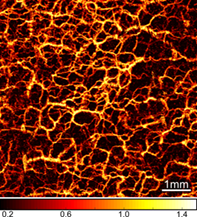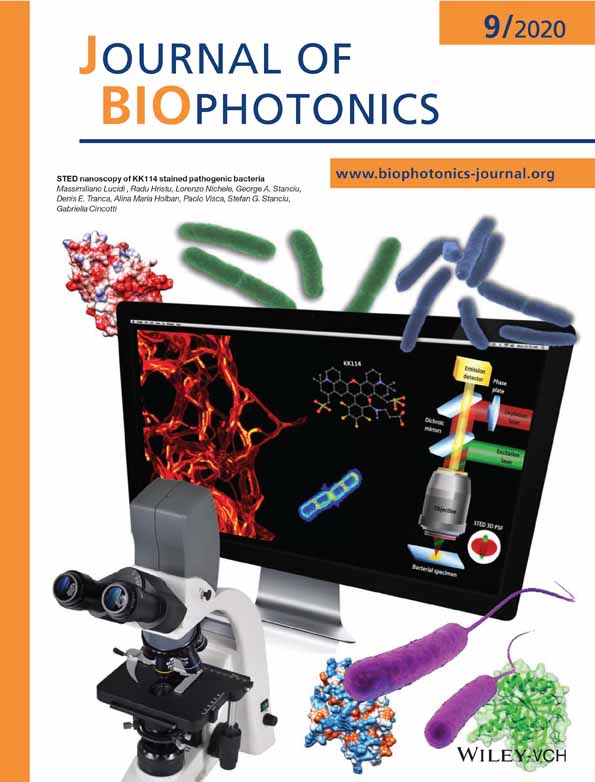Jones matrix-based speckle-decorrelation angiography using polarization-sensitive optical coherence tomography
Corresponding Author
Peijun Gong
Optical+Biomedical Engineering Laboratory, Department of Electrical, Electronic and Computer Engineering, The University of Western Australia, Perth, WA, Australia
Correspondence
Peijun Gong, BRITElab, Harry Perkins Institute of Medical Research, QEII Medical Centre, Nedlands and Centre for Medical Research, The University of Western Australia, Crawley, Western Australia, 6009, Australia.
Email: [email protected]
Search for more papers by this authorQingyun Li
Optical+Biomedical Engineering Laboratory, Department of Electrical, Electronic and Computer Engineering, The University of Western Australia, Perth, WA, Australia
Search for more papers by this authorQiang Wang
Optical+Biomedical Engineering Laboratory, Department of Electrical, Electronic and Computer Engineering, The University of Western Australia, Perth, WA, Australia
Search for more papers by this authorKarol Karnowski
Optical+Biomedical Engineering Laboratory, Department of Electrical, Electronic and Computer Engineering, The University of Western Australia, Perth, WA, Australia
Institute of Physical Chemistry, Polish Academy of Sciences, Warsaw, Poland
Search for more papers by this authorDavid D. Sampson
Surrey Biophotonics, Advanced Technology Institute and School of Biosciences and Medicine, University of Surrey, Surrey, UK
Search for more papers by this authorCorresponding Author
Peijun Gong
Optical+Biomedical Engineering Laboratory, Department of Electrical, Electronic and Computer Engineering, The University of Western Australia, Perth, WA, Australia
Correspondence
Peijun Gong, BRITElab, Harry Perkins Institute of Medical Research, QEII Medical Centre, Nedlands and Centre for Medical Research, The University of Western Australia, Crawley, Western Australia, 6009, Australia.
Email: [email protected]
Search for more papers by this authorQingyun Li
Optical+Biomedical Engineering Laboratory, Department of Electrical, Electronic and Computer Engineering, The University of Western Australia, Perth, WA, Australia
Search for more papers by this authorQiang Wang
Optical+Biomedical Engineering Laboratory, Department of Electrical, Electronic and Computer Engineering, The University of Western Australia, Perth, WA, Australia
Search for more papers by this authorKarol Karnowski
Optical+Biomedical Engineering Laboratory, Department of Electrical, Electronic and Computer Engineering, The University of Western Australia, Perth, WA, Australia
Institute of Physical Chemistry, Polish Academy of Sciences, Warsaw, Poland
Search for more papers by this authorDavid D. Sampson
Surrey Biophotonics, Advanced Technology Institute and School of Biosciences and Medicine, University of Surrey, Surrey, UK
Search for more papers by this authorAbstract
We show that polarization-sensitive optical coherence tomography angiography (PS-OCTA) based on full Jones matrix assessment of speckle decorrelation offers improved contrast and depth of vessel imaging over conventional OCTA. We determine how best to combine the individual Jones matrix elements and compare the resulting image quality to that of a conventional OCT scanner by co-locating and imaging the same skin locations with closely matched scanning setups. Vessel projection images from finger and forearm skin demonstrate the benefits of Jones matrix-based PS-OCTA. Our study provides a promising starting point and a useful reference for future pre-clinical and clinical applications of Jones matrix-based PS-OCTA.
CONFLICT OF INTEREST
The authors declare no financial or commercial conflict of interest.
REFERENCES
- 1J. Enfield, E. Jonathan, M. Leahy, Biomed. Opt. Express. 2011, 2, 1184.
- 2Y. M. Liew, R. A. McLaughlin, P. Gong, F. M. Wood, D. D. Sampson, J. Biomed. Opt. 2013, 18, 061213.
- 3C. L. Chen, R. K. Wang, Biomed. Opt. Express. 2017, 8, 1056.
- 4P. Gong, S. Es'haghian, K. A. Harms, A. Murray, S. Rea, B. F. Kennedy, F. M. Wood, D. D. Sampson, R. A. McLaughlin, J. Biophotonics. 2016, 9, 626.
- 5S. Makita, K. Kurokawa, Y. J. Hong, M. Miura, Y. Yasuno, Biomed. Opt. Express. 2016, 7, 1525.
- 6P. Gong, S. Es'haghian, F. M. Wood, D. D. Sampson, R. A. McLaughlin, Exp. Dermatol. 2016, 25, 722.
- 7M. S. Mahmud, D. W. Cadotte, B. Vuong, C. Sun, T. W. H. Luk, A. Mariampillai, V. X. D. Yang, J. Biomed. Opt. 2013, 18, 050901.
- 8S. S. Gao, Y. Jia, M. Zhang, J. P. Su, G. Liu, T. S. Hwang, S. T. Bailey, D. Huang, Invest. Ophthalmol. Vis. Sci. 2016, 57, OCT27.
- 9J. M. Schmitt, A. Knüttel, R. F. Bonner, Appl. Opt. 1993, 32, 6032.
- 10D. Levitz, L. Thrane, M. H. Frosz, P. E. Andersen, C. B. Andersen, J. Valanciunaite, J. Swartling, S. Andersson-Engels, P. R. Hansen, Opt. Express. 2004, 12, 249.
- 11P. Gong, R. A. McLaughlin, Y. M. Liew, P. R. T. Munro, F. M. Wood, D. D. Sampson, J. Biomed. Opt. 2014, 19, 021111.
- 12S. G. Adie, T. R. Hillman, D. D. Sampson, Opt. Express. 2007, 15, 18033.
- 13J. F. de Boer, T. E. Milner, J. Biomed, Opt. 2002, 7, 359.
- 14P. Gong, L. Chin, S. Es'haghian, Y. M. Liew, F. M. Wood, D. D. Sampson, R. A. McLaughlin, J. Biomed. Opt. 2014, 19, 126014.
- 15N. Wang, X. Liu, Q. Xiong, J. Xie, S. Chen, L. Liu, Opt. Lett. 2017, 42, 2996.
- 16J. F. de Boer, C. K. Hitzenberger, Y. Yasuno, Biomed. Opt. Express. 2017, 8, 1838.
- 17B. Baumann, Appl. Sci.-Basel. 2017, 7, 474.
- 18N. Lippok, M. Villiger, C. Jun, B. E. Bouma, Opt. Lett. 2015, 40, 2025.
- 19C. K. Hitzenberger, E. Gotzinger, M. Sticker, M. Pircher, A. F. Fercher, Opt. Express. 2001, 9, 780.
- 20J. F. de Boer, T. E. Milner, M. J. C. van Gemert, J. S. Nelson, Opt. Lett. 1997, 22, 934.
- 21L. Chin, X. Yang, R. A. McLaughlin, P. B. Noble, D. D. Sampson, J. Biomed. Opt. 2013, 18, 066005.
- 22Q. Li, K. Karnowski, P. B. Noble, A. Cairncross, A. James, M. Villiger, D. D. Sampson, Biomed. Opt. Express. 2018, 9, 5437.
- 23M. Villiger, D. Lorenser, R. A. McLaughlin, B. C. Quirk, R. W. Kirk, B. E. Bouma, D. D. Sampson, Sci. Rep. 2016, 6, 28771.
- 24X. Yang, L. Chin, B. R. Klyen, T. Shavlakadze, R. A. McLaughlin, M. D. Grounds, D. D. Sampson, J. Appl. Physiol. 2013, 115, 1393.
- 25Y. J. Hong, M. Miura, M. J. Ju, S. Makita, T. Iwasaki, Y. Yasuno, Invest. Ophthalmol. Vis. Sci. 2014, 55, 5016.
- 26Y. Lim, Y. J. Hong, L. Duan, M. Yamanari, Y. Yasuno, Opt. Lett. 2012, 37, 1958.
- 27B. Baumann, W. Choi, B. Potsaid, D. Huang, J. S. Duker, J. G. Fujimoto, Opt. Express. 2012, 20, 10218.
- 28E. Li, S. Makita, Y. J. Hong, D. Kasaragod, Y. Yasuno, Biomed. Opt. Express. 2017, 8, 1290.
- 29A. S. Nam, I. Chico-Calero, B. J. Vakoc, Biomed. Opt. Express. 2014, 5, 3822.
- 30B. Braaf, S. Donner, A. S. Nam, B. E. Bouma, B. J. Vakoc, Biomed. Opt. Express. 2018, 9, 486.
- 31J. Walther, Q. Li, M. Villiger, C. S. Farah, E. Koch, K. Karnowski, D. D. Sampson, Biomed. Opt. Express. 2019, 10, 1942.
- 32Y. M. Liew, R. A. McLaughlin, F. M. Wood, D. D. Sampson, Biomed. Opt. Express. 2012, 3, 1774.
- 33J. Li, J. F. de Boer, Opt. Express. 2014, 22, 21382.
- 34T. Gambichler, R. Matip, G. Moussa, P. Altmeyer, K. Hoffmann, J. Dermatol. Sci. 2006, 44, 145.
- 35Y. M. Liew, R. A. McLaughlin, F. M. Wood, D. D. Sampson, J. Biomed. Opt. 2011, 16, 116018.
- 36Q. Wang, P. Gong, B. Cense, D. D. Sampson, Biomed. Opt. Express. 2019, 10, 293.
- 37M. Villiger, B. Braaf, N. Lippok, K. Otsuka, S. K. Nadkarni, B. E. Bouma, Optica. 2018, 5, 1329.
- 38A. S. Nam, J. M. Easow, I. Chico-Calero, M. Villiger, J. Welt, G. H. Borschel, J. M. Winograd, M. A. Randolph, R. W. Redmond, B. J. Vakoc, Sci. Rep. 2018, 8, 14004.
- 39A. Mariampillai, B. A. Standish, E. H. Moriyama, M. Khurana, N. R. Munce, M. K. K. Leung, J. Jiang, A. Cable, B. C. Wilson, I. A. Vitkin, V. X. D. Yang, Opt. Lett. 2008, 33, 1530.
- 40R. A. Leitgeb, R. M. Werkmeister, C. Blatter, L. Schmetterer, Prog. Retin. Eye Res. 2014, 41, 26.
- 41R. K. Wang, S. L. Jacques, Z. Ma, S. Hurst, S. R. Hanson, A. Gruber, Opt. Express. 2007, 15, 4083.
- 42Y. Jia, O. Tan, J. Tokayer, B. Potsaid, Y. Wang, J. J. Liu, M. F. Kraus, H. Subhash, J. G. Fujimoto, J. Hornegger, D. Huang, Opt. Express. 2012, 20, 4710.




